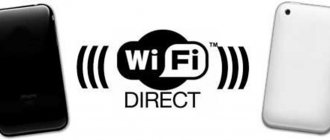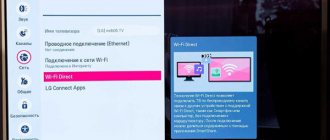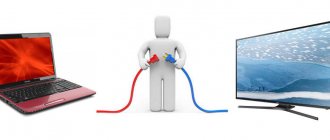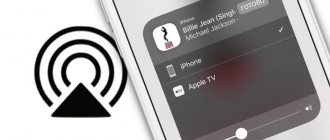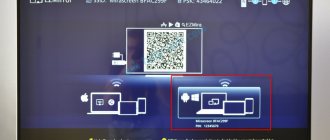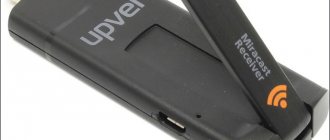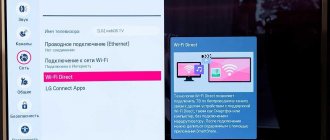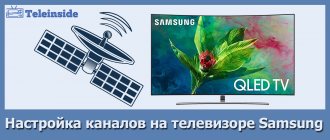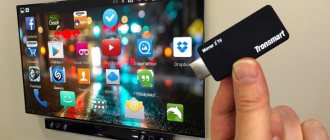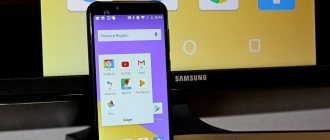According to Microsoft statistics, more than half a billion people use the Windows operating system. However, the average user only knows about a third of all functions. However, some of the unknowns are useful. They can significantly speed up work and make a person’s life easier. For example, Wi-Fi Direct on the tenth version of the OS. As soon as the feature appeared, many thematic blogs actively discussed it. However, now everyone is quiet. But in vain, because this is a universal option. How to enable Wi-Fi Direct and use this standard on Windows 10?
More about the standard
Before you enable Wi-Fi Direct, you need to understand what it is. Wireless Direct is a relatively new standard that provides connectivity to other devices. The connection occurs without an intermediary. Roughly speaking, the function allows the user to connect several devices to each other and exchange information through them. However, data transfer is not the only possibility of improved Wi-Fi. Direct is often compared to a Bluetooth wireless connection. It's practically a combination of Bluetooth and WiFi.
Please note that Direct is not available on all computers, laptops and smartphones. This is not the same as regular Wi-Fi. To use the improved standard, you need its support - a special module (adapter). If there is no chip, then the device will not support Direct.
The principle of operation is simple: two or more gadgets are connected using this standard without intermediaries. This means that the connection does not use a router or access point to redirect the signal. The main difference from a Bluetooth wireless connection is higher speed, distance and reliability, since the information is securely protected.
What is it used for?
This type of connection is often used to display a picture from a laptop to a TV. Not only “large” devices are equipped with a suitable chip, but also some tablets and phones. When connecting, it is important to remember that the connection requires support for the standard on all sides. That is, all devices must be equipped with the necessary adapter. Another purpose is file transfer. This is a faster method compared to FTP, Bluetooth, USB, etc. Also, the user can use this method to display an image through a projector or send files to a printer for printing.
How does it work
Connecting and setting up “Wi-Fi Direct” on TVs
- Hibernation in Windows 10: what is it, how to enable and disable it
Wi-Fi Direct on a laptop or PC works with standard modules in the 2.4 and 5 GHz frequencies within 802.11 a/b/g/n. The technology works by creating a software access point to which others are connected via WPS. Performance depends on the type of equipment (802.11 a, b or n), sources causing interference in the electromagnetic environment.
Important! The range of Wi-Fi Direct is no more than 200 m.
When establishing a Wi-Fi Direct connection on a laptop between devices, you need to select a safe source. Devices connected using the P2P principle are distributed according to computing power. Computers, netbooks, smartphones and game consoles have greater productivity and advanced capabilities compared to cameras, a printer or a photo frame.
Safety standard
In addition to a large number of application methods (from connecting to a printer to watching movies via TV or projector), Wi-Fi Direct is a secure standard for information transfer. The chip uses encryption and secure connection methods. In this way, developers prevent third parties from gaining access to other people's devices. Therefore, if the user creates a network, neighbors will not be able to join his TV. Also, information transmitted in this way is reliably protected.
Please note that Direct can be used to create an access point and connect to it from other computers or phones.
The adapter uses Wi-Fi Protected Setup as well as WPA2. These are two technologies that provide maximum protection. When connecting, you will need to enter a PIN code.
Advantages and disadvantages
Connecting and setting up “Wi-Fi Direct” on TVs
For comfortable “communication” of Smart devices, you can always connect Wi-Fi Monitor for Windows 10, Android 4.2 OS.
Note! Some will need to print office documents from a tablet, others will want to experience all the delights of gameplay on a wide diagonal, and others will want to set up a home theater by playing their favorite movie on the PC.
All this can be done thanks to wireless technology, the advantages of which include:
- Saving time. To show a photo gallery or video clips from a laptop on a big screen, there is no need to perform unnecessary steps, for example, wait for files to be downloaded to a Windows 7/8/10 computer. You can send media content “without intermediaries.”
- Interactivity on most devices. Photo frames, projectors, printers, scanners become much more functional and mobile with Wi-Fi Direct technology.
- Flexibility. You can quickly and deftly access the Internet wherever there is an open access point, share important content with friends on social networks here and now.
This technology also has a lot of disadvantages:
- Air pollution. There are a large number of multidirectional signals, plus paired devices are added to them.
- Safety problems. Thus, in areas with an overabundance of digital devices (offices, shopping centers), many signals create a complex topology. A client of a shared Wi-Fi network has a variety of connection options and the ability to use “neighbors” as a proxy. This may affect the security of personal data on a smartphone, laptop, tablet, etc.
- Energy consumption. The signal exhibits high power requirements. When the P2P system is turned on on the computer, the autonomy of the device is sharply reduced.
Technology characteristics
Since Direct is a modified version of traditional Wi-Fi, its characteristics have remained virtually unchanged. The frequency at which Direct operates remains the same: 2.4GHz or 5GHz. The quality of the connection and the speed of data exchange depend on the number of connected devices and obstacles in the form of other waves of the same frequency, walls, etc. Under ideal conditions, the gadget picks up the signal at a distance of up to 200 meters.
Direct allows you to create entire groups of gadgets and connect to one point. It works on the principle of a local area network (LAN). This way, users can play online by connecting to each other.
Rules for connecting technology
There are two options for connecting the program locally to exchange large volumes of information:
- DLNA provides support for multimedia traffic. Its operation depends on the presence of a central communicator.
- Miracast operates in a point-to-point format and transmits audio and video content and images interactively. The connection plays the video stream smoothly, unlike DLNA. A couple of touches of the mouse or smartphone sensor are enough to establish contact and exchange data. This technology is compatible with Windows 7/8/10, as well as Android OS starting from 4.2, as well as Smart TV.
Important! You can display video on Full HD screens only using H.264c codecs.
Thanks to the presence of Wi-Fi Direct on Windows 7 and other versions of PCs, devices will find each other themselves. To connect a laptop to an external screen, the device creates a wireless network using WPS (Wi-Fi Protected Setup), WPA2 standards.
Minuses
In addition to the advantages of being able to connect to other equipment without access to the network, exchange data, transmit media content in real time and high standard security, Wi-Fi Direct technology has several disadvantages:
- High speed of information transfer is not only an advantage. At the same time, the gadget consumes more energy. If you use a laptop without mains power, the battery will drain much faster.
- Many connections clog frequencies. If the technology is used in an office, the devices are usually interconnected. This entails pollution of the airwaves, because the more waves of the same frequency interrupt each other, the worse the signal. The problem can be partially solved by adding two bands - 2.4 GHz and 5 GHz.
- Direct's security is significantly higher than that of Bluetooth. But to access the Internet, it is recommended to use regular Wi-Fi. Direct should be enabled only if you need to display an image somewhere, connect to a printer, transfer files, and so on.
- Not all gadgets support relatively new technology. A special adapter is required for use. You can find out whether the function exists in the following way: remove the laptop lid, look at the name of the module, find information on the Internet.
What kind of technology can it be used for?
Connecting an iPhone via Wi-fi Direct to another phone or TV
The function is supported by almost all modern PCs, netbooks, as well as smartphones, tablets, photo and video cameras, and printers. The standard has several important features:
- information transfer speed reaches 250 Mbit/s;
- the range of any router reaches no more than 100 m;
- For optimal operation of Wi-Fi Direct on a tablet, PC or laptop, it is important that the gadget has this chip (2.4 GHz or 5 GHz).
Note! There are dual-band routers that simultaneously support 2.4 GHz and new 5 GHz networks - Asus RT-N18U router, Xiaomi Mini Wi-Fi, Netis WF2710, Asus RT-AC51U, etc.
The P2P standard is capable of transmitting video streams to external displays with a maximum resolution of Full HD 1080p and 5.1 surround sound.
What devices can use Wi-Fi Direct?
The list of supported devices includes the following:
- computers (with an adapter) and laptops - for connecting to other devices, transferring files, broadcasting media content on TV, etc.;
- TVs - to display the content of other devices, for example, a tablet, smartphone, laptop, PC;
- projectors and printers;
- phones and tablets.
Useful information: Other technologies are often used together with Wi-Fi Direct. For example, DLNA or Miracast. This software is designed for broadcasting videos and photos to other monitors and TVs.
Ability to connect any equipment to your home network
Wi-Fi Direct allows you to wirelessly connect any devices that support this technology. Samsung smartphones can be easily connected to a modern LG smart TV to configure it to display information stored in the mobile device.
But the ability to use a TV as an additional display is not the only function of this technology. Wi-Fi Direct is the ability to connect gadgets such as cameras, printers to the receiving device in order to print the desired file without using wires. Gaming devices and any certified mobile devices that have an antenna for Wi-Fi connection have the same capabilities. Today this sign can be found on household appliances produced by Samsung, Sony, LG and other well-known companies.
How to enable Wi-Fi Direct on Windows 10
First, you need to make sure that the function is available on the desired devices. If you can’t find information about the Wi-Fi adapter on the Internet, then try using the following guides. If you can turn it on, the device is equipped with direct connection technology.
Direct activation via key combination
To enable the network, do the following:
- Press the “Win” + “P” key combination on your laptop or computer keyboard.
- In the window that appears, select the “Connect to a wireless display” option. It is located at the bottom of the screen.
- Click on the device in the list (the function on the other gadget must be enabled).
How to enable Wi-Fi Direct through Windows settings
If the previous method did not work, then try connecting through the “Options” window. As a rule, both methods work on Windows 10, but it depends on the second gadget:
- Go to the "Options" window. Enter its name in the search bar, in the Start menu, or press the key combination “Win” + “I”.
- Select the "Devices" section. Click on "Add devices".
After this, the search for available connections will begin.
Possible problems and their solutions
Perhaps the most important thing to do first is to make sure your laptop supports this technology or not. The best way to do this is by logging onto the manufacturer’s website and looking at the characteristics there. It should indicate whether your laptop supports Wi-Fi Direct or not. And only after that start setting up and connecting devices to each other.
- Problems can only arise from the driver. Either it is out of date or it was installed unsuccessfully. Make sure you have the latest driver. Reinstall if necessary. To avoid such problems in the future, download the driver from the official website.
Flaws
Like any technology, WiFi Direct is not without its drawbacks:
- High bandwidth load that arises with the constant growth of devices. Moreover, the peculiarity of “WiFi Direct” is that for each pair their own networks are created, which are then combined with each other. The solution to this issue today lies in the transition to a higher frequency range (5 GHz).
- Possible problems in the data security protocol when using equipment outside the home Network.
- Incomplete standards, which manifests itself in the need to use a specialized module on some devices, while ideally it is assumed that one chip will be used for both WiFi and WiFi Direct.
Benefits of technology
Displaying images on TV via phone using Wi-Fi
The main advantages include:
- lack of intermediate network equipment, the ability to create a direct connection of several devices at once;
- simple steps that allow you to configure and transfer data, no need to use complex algorithms and file storage;
- high speed, unlike Bluetooth, allowing you to play streaming video in good quality.
